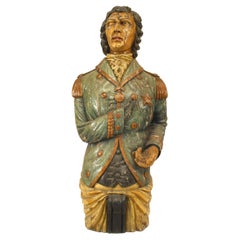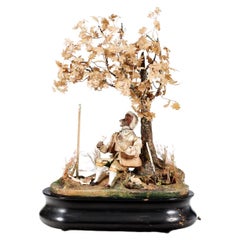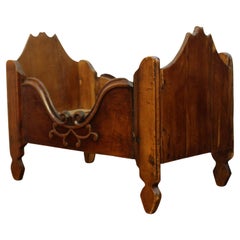Fruitwood Toys and Dolls
to
3
3
1
2
3,150
315
309
138
106
2
1
1
3
3
3
Material: Fruitwood
19th Century Polychrome Wooden Horse
Located in Brussels, Brussels
Elegant little carved wooden horse from the 19th century in polychrome wood
Very beautiful polychromy which has a lot of charm
Old child's toy with the front wheels which moves
...
Category
19th Century British Aesthetic Movement Antique Fruitwood Toys and Dolls
Materials
Fruitwood
Rare 19th Century Automaton Theater
Located in Madrid, ES
This important and rare automaton theater dates from the late 19th century and features both its original mechanical system and later electrical modifications.
Materials: Constructe...
Category
1890s Antique Fruitwood Toys and Dolls
Materials
Fruitwood
A wooden sculpture depicting a prancing carousel horse, Italy 1750.
Located in Milan, IT
Italian wooden sculpture depicting a carousel horse launched in the act of ramping. Pale fruitwood. Modern metal base. The measurement refers to the horse only. Italy mid-18th century.
Category
Mid-18th Century Italian Antique Fruitwood Toys and Dolls
Materials
Metal
Related Items
19th Century English Polychrome Carved Ship Figurehead of Lord Nelson
Located in Queens, NY
19th century English carved wooden polychrome large ship figurehead of Lord Nelson.
Category
19th Century English Victorian Antique Fruitwood Toys and Dolls
Materials
Wood, Paint
$67,500
H 60.5 in W 26 in D 20 in
Late 19th Century Automaton of a Monkey under Glass Dome
Located in Dublin 8, IE
Late 19th century automaton of a monkey in 18th century style dress. Likely to be French, this piece shows all the hallmarks of J. Phalibois, one of the foremost makers of clockwork toys...
Category
1880s French Victorian Antique Fruitwood Toys and Dolls
Materials
Glass, Wood, Silk
18th Century Carved Wooden Angel
Located in Houston, TX
Carved wooden angel from Private Chapel in Provence. Wonderful detail in Angel's hair and draped dress. Figure is mounted on an iron stand.
Category
18th Century French Folk Art Antique Fruitwood Toys and Dolls
Materials
Iron
Colorful Painted Carousel Style Rocking Horse
Located in Bridgeport, CT
A remarkable large scale painted rocking horse decorated in the manner of a carousel horse. The white horse with brown mane and tail wears a red saddle on a blue blanket. The rump is decorated with a blond female mask flanked by pink and white dogwood flowers, the breast with the same flowers. With inset plastic colored faceted stones overall. With two brass twisted rods mounted on the white rocker...
Category
20th Century Hollywood Regency Fruitwood Toys and Dolls
Materials
Wood
A 19th Century Polish Shofar
Located in New York, NY
A 19th-century Polish Shofar which is a remarkable piece of Judaica reflecting the Jewish community's life in Poland during that era.
Poland was home to one of the largest and most...
Category
19th Century Polish Antique Fruitwood Toys and Dolls
Materials
Horn
Pair of Silvered Wooden Reliquaries from France, Circa 1750
Located in Dallas, TX
This pair of silvered wooden reliquaries are from France, circa 1750. The backs are still preserved by wax seals, indicating that the relics were never removed.
Each reliquary has...
Category
Mid-18th Century French Antique Fruitwood Toys and Dolls
Materials
Silver
$2,400 / set
H 13.25 in W 6.375 in D 2.5 in
Rare 19th Century English Tunbridgeware Hair Pin or Slide
Located in Dallas, TX
PRESENTING an EXTREMELY UNIQUE and RARE 19C British Tunbridgeware Hair Pin/Bobbin or Slide.
This slide is unlike any of it’s kind we have seen before, it is a VERY RARE survivor.
From circa 1860 – 80 and made in Tunbridge Wells, England.
Made of walnut with gorgeous marquetry inlay on the entirety of the front with classic Tunbridgeware micro-mosaic all over the front. The rear is walnut.
The marquetry inlay appears to be various different woods, namely, maple, walnut and satinwood.
Would have been worn in a Lady’s hair bun with the micro-mosaic facing forward.
This would have belonged to a VERY ELEGANT LADY in the mid to late 19th Century.
Tunbridge ware is a form of decoratively inlaid woodwork, typically in the form of boxes, that is characteristic of Tonbridge and the spa town of Royal Tunbridge Wells in Kent in the 18th and 19th centuries. The decoration typically consists of a mosaic of many very small pieces of different coloured woods that form a pictorial vignette. Shaped rods and slivers of wood were first carefully glued together, then cut into many thin slices of identical pictorial veneer with a fine saw. Elaborately striped and feathered bandings for framing were pre-formed in a similar fashion.
There is a collection of Tunbridge ware in the Tunbridge Wells Museum and Art Gallery in Tunbridge Wells.
The famous makers of Tunbridge ware were in the Tunbridge Wells area of Kent; their most notable work was from circa 1830-1900.
Early makers of Tunbridge ware, in Tunbridge Wells in the mid-18th century, were the Burrows family, and Fenner and Co. In the 19th century, around 1830, James Burrows invented a technique of creating mosaics from wooden tesserae. Henry Hollamby, apprenticed to the Burrows family, set up on his own in 1842 and became an important manufacturer of Tunbridge ware, employing about 40 people.
Edmund Nye (1797–1863) and his father took over the Fenner company when William Fenner retired in 1840, after 30 years in partnership with him. Thomas Barton (1819–1903), previously apprenticed at the Wise factory, joined the Nyes in 1836, and worked as Nye’s designer; he took over the business in 1863 and continued there until his death.
In Tonbridge (near to Tunbridge Wells), George Wise (1703–1779) is known to have had a business in 1746. It continued with his son Thomas, and Thomas’s nephew George (1779–1869), who took over in 1806. In its early years the company made articles such as workboxes and tea caddies with prints of popular views; later items had pictures created from mosaics. Their workshop in Tonbridge, Wise’s Tunbridge Ware Manufactory, was next to the Big Bridge over the Medway; the building was demolished in 1886 to widen the approach to the bridge.
Tunbridge ware became popular with visitors to the spa town of Tunbridge Wells, who bought them as souvenirs and gifts. Articles included cribbage boards, paperweights, writing slopes, snuffboxes and glove boxes.
At the Great Exhibition of 1851, Tunbridge ware by Edmund Nye, Robert Russell and Henry Hollamby was shown; Edmund Nye received a commendation from the judges for his work. He exhibited a table depicting a mosaic of a ship at sea; 110,800 tesserae were used in making the picture.
The manufacturers of Tunbridge ware were cottage industries, and they were no more than nine in Tunbridge Wells and one in Tonbridge. The number declined in the 1880s; competent craftsmen were hard to find, and public tastes changed. After the death of Thomas Barton in 1903 the only surviving firm was Boyce, Brown and Kemp, which closed in 1927.
Marquetry was an old technique which was continued by Nye and Barton to create images such as birds or butterflies.
‘Green Oak’ as caused by the fungus Chlorociboria aeruginascens.
Stickware and half-square mosaic was invented by James Burrows in about 1830: a bunch of wooden sticks of different colours, each having triangular or diamond-shaped cross section, were tightly glued together; in the case of stickware, the resulting block was dried, then turned to form an article such as the base of a pincushion. For half-square mosaic, thin slices were taken from the composite block, and applied to a surface.
Tesselated mosaic, was a development by James Burrows of half-square mosaic; it was adopted by George Wise and Edmund Nye. Minute tesserae were used to form a wide variety of geometric and pictorial designs.
Many sorts of wood were used for the various colours; about 40 were in regular use. Only natural colors were used; green was provided by “green oak”, produced by the action of fungus on fallen oak. Designs for articles were often taken from designs of Berlin wool work.
Category
Late 19th Century English High Victorian Antique Fruitwood Toys and Dolls
Materials
Satinwood, Walnut
Pair of 19th Century Brass Parabolic Reflectors
Located in Chicago, IL
In the 19th century, parabolic reflectors such as these were employed in scientific experiments to study the behavior of light, heat, and sound. These brass parabolic mirrors, when p...
Category
19th Century American Victorian Antique Fruitwood Toys and Dolls
Materials
Brass
Mid-19th Century French Carved Giltwood and Polychromed Virgin Mary Statue
Located in Dallas, TX
This beautiful, antique sculpture of the Virgin Mary in prayers was created in Pyrenees of France, circa 1860. Embellished with gold leaf and polychrome finish, the Classic religious...
Category
Mid-19th Century French Antique Fruitwood Toys and Dolls
Materials
Giltwood
$2,975
H 22 in W 8 in D 7 in
Mid-Late 19th c. Carved Horse c.1850-1890
Located in San Francisco, CA
ABOUT
A mid to late 19th century carved wooden horse with horsehair mane and tail, fabric ears, saddle, harness and nail-head eyes.
CREATOR Unknown. Made in Germany or the USA....
Category
Mid-19th Century American Industrial Antique Fruitwood Toys and Dolls
Materials
Wood, Fabric
Set of 6 Rare French 19th Century Antique Doll Carriages
Located in Hopewell, NJ
Bought in the south of France this set of antique doll carriages are an enchanting collection with wooden handles, original paint, and working wh...
Category
19th Century French Antique Fruitwood Toys and Dolls
Materials
Metal
19th Century French Automaton
Located in San Francisco, CA
Fabulous rare 19th century automaton. Most likely made in France at the end of the 19th century. She is a real beauty and in remarkable condition for her age. She is made of porcelain and cloth. When you wind her she bends her head and raises bouquet to smell the flowers. With the stand she is 15 1/2 inches high. Just herself measures 11 1/2 inches high. Approximately 5 1/2 inches in width and depth. There is a monogram on the back of her neck that appears to be the letter C...
Category
19th Century French Victorian Antique Fruitwood Toys and Dolls
Materials
Porcelain
Previously Available Items
Antique Smoking Turkish Automaton
Located in Madrid, ES
Antique Smoking Turkish Automaton
A fascinating 20th-century automaton depicting a seated Turkish figure smoking a shisha. This automaton is in perfec...
Category
1940s Vintage Fruitwood Toys and Dolls
Materials
Fruitwood
19th Century, Country French Directoire Period Infant's Bed
Located in Chapel Hill, NC
Late 19th-early 19th century country French Directoire period infant's bed. Ideal for a doll collection or beloved mini-canine or cat. Fruitwood. Nicely molded throughout. The sides ...
Category
19th Century French Directoire Antique Fruitwood Toys and Dolls
Materials
Fruitwood
10 Spheres Weighting Only Twice and Try to Find the Heaviest One, France 1900
Located in Milan, IT
The ball weight riddle. There are 10 painted wood balls available, same circumference, all of them, numbered from 0 to 9, 9 of which have the same weight and only one weight more tha...
Category
1890s French Antique Fruitwood Toys and Dolls
Materials
Fruitwood
H 5.5 in W 5.5 in D 5.5 in
19th Century French Miniature Fruitwood Faux Bamboo and Cane Doll Chair
Located in Stamford, CT
19th century French miniature fruitwood faux bamboo carved wood chair with original caned seat. Seat is 6" H.
Category
Mid-19th Century French Rustic Antique Fruitwood Toys and Dolls
Materials
Cane, Fruitwood






